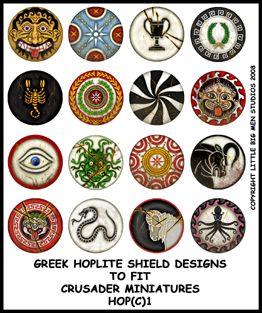

640 BCE, depicting Greek hoplites with shields decorated with a variety of symbols and patterns (As I discuss in this article I wrote in October 2020, the ancient Greeks widely used Medousa’s face as an apotropaic symbol to frighten away malevolent supernatural forces, so it only makes sense that a soldier would paint this symbol on his shield.)ĪBOVE: Detail of the Chigi Vase, a Proto-Corinthian olpe dated to between c. The soldier on the end has the face of the Gorgon Medousa, which is evidently meant to strike fear into the enemy hoplites. One hoplite has the head of a bull on his. The shield designs of the army on the right are clearly visible.Ī couple hoplites have images of birds on their shields. The vase depicts two armies of hoplites lined up to fight each other. 640 BCE that was discovered in an Etruscan tomb in 1881. Below, for instance, is the famous Chigi Vase, a Proto-Corinthian olpe dated to between c. Surviving ancient Greek depictions of hoplites’ shields reveal the sheer diversity of the decorations they used. Greek hoplites regularly decorated their own shields with a wide array of diverse personal symbols, geometric designs, and images. Consequently, a hoplite’s shield was his personal property, not property issued to him by the state, and shields were not at all uniform. In historical reality, Greek hoplites in all poleis, including Sparta, were expected to provide their own equipment. In that article, I briefly address the inaccuracy of the Spartans all having identical shields, but I don’t talk about the use of the letter lambda specifically and whether it is accurate.ĪBOVE: Screenshot of the current revision of the Wikipedia article “Sparta,” showing the shield with the letter lambda in the infobox I’ve already written an entire article about how the film 300 is a wildly historically inaccurate piece of propaganda that deliberately distorts history to promote a right-wing extremist message that can be described as borderline fascist at best.
#SPARTAN HOPLITE SHIELD TRANSFERS SERIES#
Notably, in the 2006 fantasy action film 300, directed by Zack Snyder and based on the 1998 limited comic book series 300 by Frank Miller, all the Spartans are portrayed using perfectly uniform, unpainted, iron shields embossed with the letter lambda. The misconception that all Spartan hoplites always carried shields bearing the letter lambda is absolutely ubiquitous in popular culture. Although there is evidence to suggest that a few Spartans probably did choose to decorate their shields with the letter lambda, the vast majority seem to have decorated their shields with other symbols, geometric designs, and images. In historical reality, Greek hoplites, including Spartan hoplites, were expected to provide their own equipment and they could decorate their shields however they wished. This letter, of course, stands for Λακεδαίμων ( Lakedaímōn), which was the most common name in antiquity for the Greek polis (i.e., “city-state”) that included that settlement of Sparta. Publishers use these marks when books are returned to them.In popular culture, ancient Spartan hoplites are virtually always portrayed as fighting with shields decorated with the Greek letter lambda (Λ).

The cardboard backing of miniature packs is not graded.In most cases, boxed games and box sets do not come with dice.Due to the nature of loose counters, if a game is unplayable it may be returned for a refund of the purchase price. Boardgame counters are punched, unless noted.Major defects and/or missing components are noted separately.Example, EX+ is an item between Excellent and Near Mint condition. A "plus" sign indicates that an item is close to the next highest condition.When only one condition is listed, then the box and contents are in the same condition.
#SPARTAN HOPLITE SHIELD TRANSFERS CODE#
Boxed items are listed as "code/code" where the first code represents the box, and the second code describes the contents.


 0 kommentar(er)
0 kommentar(er)
